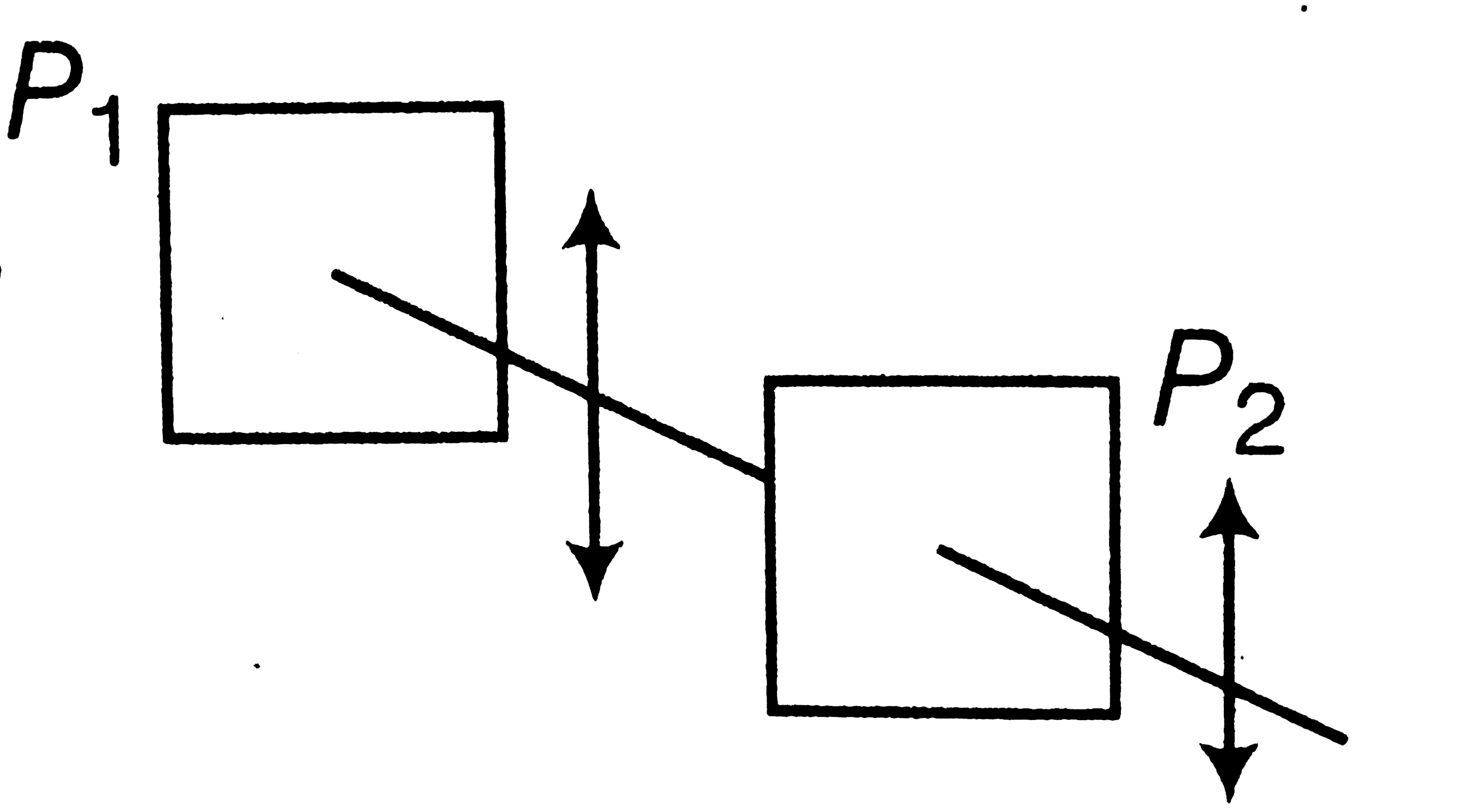Light from a sodium lamp (S) passes through two polaroid sheets P1 and P2 as shown in figure. What will be the effect on the intensity of the light transmitted (i) by P1 and (ii) by P2 on rotating polaroid P1 about the direction of propagation of light ? Justify your answer in both cases.

(i) When monochromatic light of Intensity lo passes through the polaroid Pi, the transmitted light becomes plane polarised whose intensity is I1=I02 . This intensity I1 does not change even on becomes plane polarised whose internsity is I1=I02 . This internsity I1 does not change even on rotating P1 about the direction of propagation of light.
(ii) If pass axis of polaroid sheet P2 subtends an angle θ with that of polaroid P1, then in accordance with Malus law the intensity of transmitted light is I2=I1cos2θ=12I0cos2θ. If polaroid sheet P1 is rotatecd about the direction of propagation of light, then value of 0 and consequently intensity I2 varies between the limiting values I02 and zero.
Topper's Solved these Questions
- CBSE EXAMINATION PAPER 2020 (SOLVED)BOOK - U-LIKE SERIESCHAPTER - CBSE EXAMINATION PAPER 2020 (SOLVED)EXERCISE - SECTION C
11 Videos
- CBSE EXAMINATION PAPER 2020 (SOLVED)BOOK - U-LIKE SERIESCHAPTER - CBSE EXAMINATION PAPER 2020 (SOLVED)EXERCISE - SECTION D
11 Videos
- CBSE EXAMINATION PAPER 2020 (SOLVED)BOOK - U-LIKE SERIESCHAPTER - CBSE EXAMINATION PAPER 2020 (SOLVED)EXERCISE - SECTION D
11 Videos
- CBSE EXAMINATION PAPER 2020 BOOK - U-LIKE SERIESCHAPTER - CBSE EXAMINATION PAPER 2020 EXERCISE - SECTION D
12 Videos
- CBSE EXAMINATION PAPER 2020 (SOLVED) BOOK - U-LIKE SERIESCHAPTER - CBSE EXAMINATION PAPER 2020 (SOLVED) EXERCISE - SECTION - D
6 Videos
Similar Questions

If a polarised light of intensity l0/2 is passed through two polariods P1 and P2 as shown in figure. Then the intensity of light observed by an observer on other side of P2 (if the polaroid P1 is rotated clockwise) as a funtion of angle θ.
View Solution(a) Light, from a sodium lamp, is passed through two polaroid sheets P1 and P2 kept one after the other. Keeping P1 fixed, P2 is rotated so the its 'pass-axis' can be at different angles, θ, with respect to the pass-axis of P1
An experimentalist records the following data for the intensity of light coming out P2 as a function of the angle θ.

[I0= Intensity of beam falling on P1]
One of these observation is not is agreement with expected theoretical variation of l. ldentify this observation and write the correct expression.
(b) Define Brewster angle and write the expression for it in terms of the refractive index of the medium.
View Solution
Knowledge Check

If a polarised light of intensity l0/2 is passed through two polariods P1 and P2 as shown in figure. Then the intensity of light observed by an observer on other side of P2 (if the polaroid P1 is rotated clockwise) as a funtion of angle θ.A B
B C
C D
D
When light passes through two polaroids P1andP2, then transmitted polarisation is the component parallel to the polaroid axis.
Which of the following is correct?A B
B C
C D
D
Light from sodium lamp is made to pass through two polaroid placed one after the other in the path of light. Taking the intensity of the incident light as 100%, the intensity of the out coming light that can be varied in the range
A0% to 100%B0% to 50%C0% to 25%D0% to 75%
(a) Light, from a sodium lamp, is passed through two polaroid sheets P1 and P2 kept one after the other. Keeping P1 fixed, P2 is rotated so the its 'pass-axis' can be at different angles, θ, with respect to the pass-axis of P1
An experimentalist records the following gata for the intesity of light coming out P2 as a function of the angle θ.

[I0= Intensity of beam falling on P1]
One of these observation is not is agreement with expected theoretical variation of l. ldentify this observation and write the correct expression.
(b) Define Brewster angle and write the expression for it in terms of the refractive index of the medium.
View SolutionAn unpolarized light with intensity 2I0 is passed through a polaroid. The resultant intensity of the transmitted light will be
View SolutionAn unpolarized light with intensity 2I0 is passed through a polaroid. The resultant intensity of the transmitted light will be
View SolutionLight from an ordinary source (say a sodium lamp) is passed through a polaroid sheet P1. The transmitted light is then made to pass through a second polaroid sheet P2 which can be rotated so that the angle θ between the two polaroid sheets varies from 0∘ to 90∘. Show graphically the variation of intensity of light transmitted by P1 and P2 as a function of angle θ. Take incident beam intensity I0. Why does light from clear blue portion of sky show a rise and fall of intensity when viewed through a polaroid which is rotated ?
View SolutionLight from sodium lamp is made to pass through two polaroids placed one after the other in the path of light. Taking the intensity of the incident light as 100%, the intensity of the out coming light that can be varied in the range
View Solution
